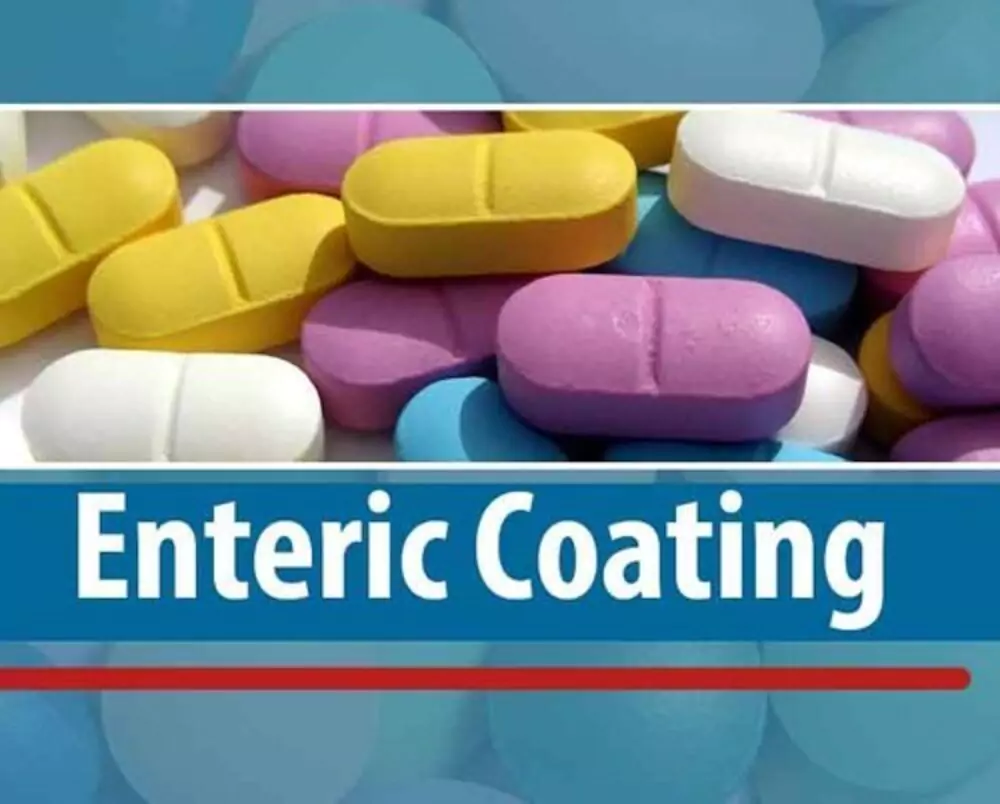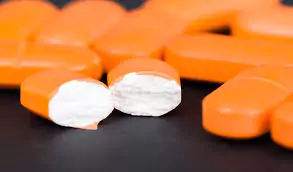우리가 약에 대해 생각할 때, 우리는 종종 그것이 어떻게 우리의 기분을 나아지게 하는지에 초점을 맞춥니다. 하지만 약이 만들어지는 방식이 그 효과에 영향을 미칠 수 있다는 것을 알고 계셨나요?
중요한 두 가지 제약의 종류 약물이 더 잘 작용하도록 돕는 코팅은 장용 코팅과 필름 코팅입니다. 두 가지 방법 모두 정제를 코팅하여 보호하고 약물이 방출되는 방식을 제어합니다.
이러한 약학용 코팅에 대해 알아보고, 이것이 약에 어떤 영향을 미치는지, 그리고 어떤 코팅이 본인에게 가장 적합할지 알아보겠습니다.

고품질 코팅 장비로 생산성을 높일 준비가 되셨나요?
장용 코팅과 필름 코팅은 제약 산업에서 사용되는 두 가지 인기 있는 방법입니다. 두 공정 모두 성분을 보호하고 소화계의 올바른 부위에 전달되도록 하여 약물의 효과를 높이도록 설계되었습니다.
비슷한 목적을 가지고 있지만, 그 응용 분야와 특성은 서로 다릅니다.

장용 코팅이란? 장용 코팅은 일부 정제에 씌워지는 특수한 층입니다. 이 코팅은 위산으로부터 내부의 약을 보호하는 데 도움이 됩니다.
코팅은 위가 아닌 장에서 용해되도록 만들어졌습니다. 이는 일부 약물이 위산에 의해 손상될 수 있고, 장용 코팅이 약물을 안전하게 유지하는 데 도움이 되기 때문에 중요합니다.
장용 코팅은 일반적으로 위의 산성 환경을 견뎌내는 특수 소재로 만들어집니다. 이를 통해 약이 장에 도달하여 제대로 흡수될 때까지 그대로 유지됩니다.
장용 코팅 정제를 깨지 않는 것이 중요합니다. 깨면 코팅이 손상될 수 있습니다. 즉, 약이 장 대신 위장에서 녹을 수 있습니다. 그럴 경우 약이 제대로 작용하지 않을 수 있으며, 위장 장애가 발생할 수 있습니다.
예를 들어, 속쓰림을 완화하는 용도로 장용코팅 정제를 복용하고 있다면, 이를 깨면 약이 장에서 효과적으로 작용하기보다 오히려 위장 자극을 일으킬 수 있습니다.
아니요, 장용 코팅 정제를 부수는 것은 좋은 생각이 아닙니다. 부수면 코팅이 깨집니다. 이것은 약의 작용 방식을 바꿀 수 있습니다. 약 복용에 도움이 필요하면 항상 의사나 약사와 상의하세요.
어떤 사람들은 정제를 부수면 삼키기가 더 쉬워질 것이라고 생각할 수 있지만, 의도치 않은 결과를 초래할 수 있습니다. 장용정을 복용해야 하는 경우 정제를 통째로 삼키거나 가능하다면 액상 버전을 요청하는 등 대체 방법을 찾아보세요.

필름 코팅이란? 필름 코팅은 정제를 보호하는 또 다른 방법입니다. 정제 위에 얇은 층을 바르는 것을 포함합니다. 이 층은 정제를 삼키기 쉽게 만드는 데 도움이 될 수 있습니다.
필름 코팅은 또한 약을 습기와 빛으로부터 보호할 수 있습니다. 장용 코팅과 달리 필름 코팅은 일반적으로 위에서 용해됩니다. 즉, 약이 빠르게 작용하기 시작할 수 있습니다.
필름 코팅은 일반적으로 위장관에서 쉽게 용해되는 폴리머로 만들어집니다. 즉, 정제가 위장에 들어가자마자 코팅이 분해되어 약물이 방출되고 혈류로 흡수될 수 있습니다.
필름 코팅 정제는 표면이 더 매끈하기 때문에 환자에게 더 매력적입니다. 이로 인해 삼키기가 더 쉽습니다. 필름 코팅은 또한 향이 나는데, 이는 내부 성분의 불쾌한 맛을 가리는 데 도움이 될 수 있습니다.
필름 코팅은 맛을 개선하는 것 외에도 습기와 빛이 정제를 분해하는 것을 방지하는 보호 장벽을 제공합니다. 따라서 필름 코팅 정제는 시간이 지나도 효과를 유지해야 하는 많은 유형의 약물에 적합한 선택입니다.
장용코팅과 필름코팅의 주요 차이점을 살펴보겠습니다.
| 특징/특징 | 장용코팅 | 필름코팅 |
| 목적과 기능 | 위산으로부터 보호하고 장에서 방출합니다. | 삼키기 편리함 향상, 습기로부터 보호 |
| 해산 위치 | 장내에서 용해된다 | 뱃속에서 녹아내린다 |
| 재료 구성 | 산성에 강한 폴리머로 제작 | 쉽게 용해되는 폴리머로 제작 |
| 신청 유형 | 위산에 민감한 약물에 사용 | 다양한 약물에 사용됨 |
| 비용 및 생산 복잡성 | 일반적으로 더 비싸고 복잡합니다 | 일반적으로 비용이 저렴하고 적용이 쉽습니다. |
| 약물 방출을 제어하는 능력 | 장내에서 조절된 방출을 허용합니다 | 주로 즉시 출시되도록 설계되었습니다. |
장용 코팅은 약을 위산으로부터 보호하고 장에서 용해되도록 합니다. 필름 코팅은 정제를 삼키기 쉽게 만들고 습기로부터 보호합니다. 각 코팅은 약의 특정 요구 사항에 따라 고유한 기능을 합니다.
장용 코팅 정제는 장에서 용해됩니다. 필름 코팅 정제는 위에서 용해됩니다. 이것은 약물이 신체에서 어떻게 그리고 언제 방출되는지에 중요합니다. 예를 들어, 약물이 최대 효과를 위해 장에서 흡수되어야 하는 경우 장용 코팅이 필수적입니다.
장용 코팅은 종종 폴리머와 같은 위산에 저항하는 재료로 만들어집니다. 필름 코팅은 일반적으로 위에서 쉽게 용해되는 재료로 만들어집니다. 재료 선택은 정제가 섭취된 후 어떻게 작동하는지에 영향을 미칩니다.
장용 코팅은 위산을 피해야 하는 약에 사용됩니다. 필름 코팅은 많은 유형의 정제, 특히 삼키기 어려운 정제에 사용할 수 있습니다. 이러한 다재다능함으로 인해 필름 코팅은 제약 산업에서 인기 있는 선택이 되었습니다.
장용 코팅은 필름 코팅에 비해 적용 비용이 더 많이 들고 복잡할 수 있습니다. 장용 코팅에 관련된 재료와 공정은 주의 깊게 취급해야 하기 때문입니다. 제조업체는 적절한 코팅을 보장하기 위해 특수 장비와 기술이 필요할 수 있습니다.
장용 코팅은 장에서 약물의 조절된 방출을 허용합니다. 필름 코팅은 방출을 조절하는 데 도움이 될 수 있지만 주로 보호 및 삼키기 용이성을 위해 설계되었습니다. 각 코팅이 약물 방출에 어떤 영향을 미치는지 이해하는 것은 제조업체와 의료 서비스 제공자에게 중요합니다.

슈가코팅과 필름코팅에 관심이 있으시다면, 이전 기사를 확인해보세요!
장용코팅과 필름코팅 중 선택할 때 다음과 같은 중요한 요소를 고려하세요.
| 요인 | 장용코팅 | 필름코팅 |
| 올바른 관리 | 깨지거나 으깨져서는 안됩니다 | 씹거나 부수어 먹을 수 있습니다(지침에 따라 다름) |
| 부작용 피하기 | 위장 자극을 예방합니다 | 위산에 대한 보호가 되지 않을 수 있습니다 |
| 약물 상호작용 | 다른 약물과 함께 복용 시 위장 자극을 줄이는 데 도움이 됩니다. | 상호 작용에 대한 보호를 제공하지 못할 수 있습니다. |
| 약물 안전 | 위장을 자극하는 약물에 안전함 | 일반적으로 안전하지만 특정 보호 기능을 제공하지 않을 수 있습니다. |
약을 복용하기 위한 지침을 반드시 따르세요. 일부 정제는 통째로 두어야 하지만, 다른 정제는 씹거나 부술 수 있습니다. 예를 들어, 장용 코팅 정제는 부수거나 부수어서는 안 됩니다. 이렇게 하면 의도한 대로 효과가 나타납니다.
올바른 코팅을 선택하면 부작용을 예방하는 데 도움이 될 수 있습니다. 일부 약물은 적절하게 코팅되지 않으면 위장 장애를 일으킬 수 있습니다. 예를 들어, 장용 코팅은 민감한 약물을 위의 혹독한 환경으로부터 보호하는 데 도움이 될 수 있습니다.
이것은 위 점막을 자극하는 것으로 알려진 약물의 경우 특히 중요합니다. 이러한 약물이 장용 코팅되지 않은 경우 불편함을 유발하고 환자의 순응도를 낮출 수 있습니다.
일부 약물은 다른 약물과 부정적으로 상호 작용할 수 있습니다. 코팅 선택은 이러한 상호 작용을 관리하는 데 도움이 될 수 있습니다. 예를 들어, 장용 코팅 약물은 위장 자극을 일으킬 수 있는 다른 약물을 복용하는 환자에게 더 나은 선택일 수 있습니다.
이를 통해 전반적인 치료 경험이 개선되고 사용되는 약물의 효과가 향상될 수 있습니다. 의료 서비스 제공자와 잠재적인 상호 작용에 대해 논의하면 특정 상황에 가장 적합한 코팅을 결정하는 데 도움이 될 수 있습니다.
코팅이 의도한 용도에 안전한지 확인하는 것이 중요합니다. 장용 코팅과 필름 코팅은 일반적으로 안전하지만, 우려 사항이 있는 경우 항상 의료 서비스 제공자와 상의해야 합니다. 약물 안전에 대한 코팅의 의미를 이해하면 정보에 입각한 결정을 내리는 데 도움이 될 수 있습니다.
예를 들어, 일부 환자는 코팅에 사용되는 특정 재료에 알레르기가 있을 수 있습니다. 이를 알고 있으면 잠재적인 부작용을 피하고 환자가 약을 복용하는 동안 안전을 보장하는 데 도움이 될 수 있습니다.
고품질 코팅 솔루션을 찾고 계시다면 Canaan을 고려해보세요. 코팅기.
우리는 장용 및 필름 코팅 공정 모두에 대해 안정적이고 효율적인 옵션을 제공합니다. 이러한 기계는 약물이 적절하게 코팅되도록 보장하여 효과를 향상시킵니다.
문의하기 오늘 자세히 알아보세요!

제약 제3자 제조는 회사가 제품 생산을 전문 회사에 아웃소싱하는 경우입니다. 이 관행을 통해 회사는 연구 개발에 집중할 수 있습니다. 이 가이드에서는 제3자 제조의 이점, 프로세스 및 고려 사항을 다룹니다. 주요 요점 제약 제3자 제조 이해 제약 제3자 제조는 회사가 […]

약물 발견은 질병에 대한 새로운 치료법을 찾는 데 필수적입니다. 이 프로세스는 약물 표적을 식별하는 것으로 시작하여 안전하고 효과적인 약물을 시장에 출시하는 것으로 끝납니다. 이 기사에서는 약물 발견의 각 단계를 설명하고 오늘날 이 분야를 변화시키는 혁신을 강조합니다. 주요 요점 약물 발견 프로세스는 복잡하며 여러 가지 […]

제약 회사를 시작하는 방법을 알고 싶다면 시장 조사 수행, 사업 계획 개발, 자금 확보, 규제 요건 탐색이 포함됩니다. 이 가이드에서는 성공적인 제약 사업을 시작하고 성장시키는 데 도움이 되는 이러한 중요한 단계와 기타 사항을 다룹니다. 주요 요점 포괄적인 시장 조사 수행 제약 회사 시작 […]